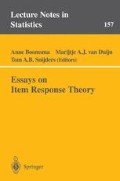Abstract
Confronted with incomplete data due to nonresponse, a researcher may want to impute missing values to estimate latent properties of respondents. In this chapter the results of a simulation study are presented, investigating the performance of several imputation techniques. Some imputation procedures are based on item response theory (IRT) models, which can also be used to estimate latent abilities directly from the incomplete data by using incomplete testing designs when data are missing by design. This strategy has some serious disadvantages in the case of item nonresponse, because nonresponse is assumed to be ignorable and computational problems arise in scales with many items. In a second simulation study, the performance of some imputation techniques is compared to the incomplete design strategy, in the case of item nonresponse. The latter strategy results in slightly better ability estimates, but imputation is almost as good, especially when it is based on IRT models.
Access this chapter
Tax calculation will be finalised at checkout
Purchases are for personal use only
Preview
Unable to display preview. Download preview PDF.
References
Bethlehem, J.G. (1988). Reduction of nonresponse bias through regression estimation. Journal of Official Statistics, 4, 251–260.
Eggen, T.J.H.M. (1993). Itemresponstheorie en onvolledige gegevens [Item response theory and incomplete data]. In T.J.H.M. Eggen & P.F. Sanders (Eds.), Psychometrie in de praktijk (pp. 239–284). Arnhem: CITO.
Eggen, T.J.H.M., & Verhelst, N.D. (1992). Item calibration in incomplete testing designs (Measurement and Research Department Reports, 92-3). Arnhem: CITO.
Huisman, M. (1999). Item nonresponse: Occurrence, causes, and imputation of missing answers to test items (M&T Series 32). Leiden: DSWO Press.
Little, R.J.A. (1988). Missing-data adjustments in large surveys. Journal of Business & Economic Statistics, 6, 287–296.
Little, R.J.A., & Rubin, D.B. (1987). Statistical analysis with missing data. New York: Wiley.
Mislevy, R.J., & Wu, P.-K. (1996). Missing responses and IRT ability estimation: Omits, choice, time limits, and adaptive testing (Research Report RR-96-30-ONR). Princeton, NJ: Educational Testing Service.
Mokken, R.J. (1971). A theory and procedure of scale analysis: With applications in political research. The Hague: Mouton.
Molenaar, I.W. (1997). Nonparametric models for polytomous responses. In W.J. van der Linden & R.K. Hambleton (Eds.), Handbook of modern item response theory (pp. 369–380). New York: Springer-Verlag.
Molenaar, I.W., & Sijtsma, K. (1984). Internal consistency and reliability in Mokken’s nonparametric item response model. Tijdschrift voor Onderwijsresearch, 9, 257–268.
Nap, R.E. (1994). OPMISS: Handling missing data in OPLM (Heymans Bulletin HB-94-1173-IN). University of Groningen, Department of Statistics & Measurement Theory.
Rubin, D.B. (1976). Inference and missing data. Biometrika, 63, 581–592.
Rubin, D.B. (1983). Conceptual issues in the presence of nonresponse. In W.G. Madow, I. Olkin, & D.B. Rubin (Eds.), Incomplete data in sample Surveys, Vol. II: Theory and bibliographies (pp. 123–142). New York: Academic Press.
Rubin, D.B. (1987). Multiple imputation for nonresponse in surveys. New York: Wiley.
Rubin, D.B., Stern, H.S., & Vehovar, V. (1995). Handling “don’t know” survey responses: The case of the Slovenian plebiscite. Journal of the American Statistical Association, 90, 822–828.
Sande, I.G. (1982). Imputation in surveys: Coping with reality. The American Statistician, 36, 145–152.
Verhelst, N.D., & Glas, C.A.W. (1995). The one parameter logistic model. In G.H. Fischer & I.W. Molenaar (Eds.), Rasch models. Foundations, recent developments, and applications (pp. 215–237). New York: Springer-Verlag.
Verhelst, N.D., Glas, C.A.W., & Verstralen, H.H.F.M. (1995). One-parameter logistic model: OPLM [Software manual]. Arnhem: CITO.
Author information
Authors and Affiliations
Editor information
Editors and Affiliations
Rights and permissions
Copyright information
© 2001 Springer Science+Business Media New York
About this chapter
Cite this chapter
Huisman, M., Molenaar, I.W. (2001). Imputation of Missing Scale Data with Item Response Models. In: Boomsma, A., van Duijn, M.A.J., Snijders, T.A.B. (eds) Essays on Item Response Theory. Lecture Notes in Statistics, vol 157. Springer, New York, NY. https://doi.org/10.1007/978-1-4613-0169-1_13
Download citation
DOI: https://doi.org/10.1007/978-1-4613-0169-1_13
Publisher Name: Springer, New York, NY
Print ISBN: 978-0-387-95147-8
Online ISBN: 978-1-4613-0169-1
eBook Packages: Springer Book Archive

